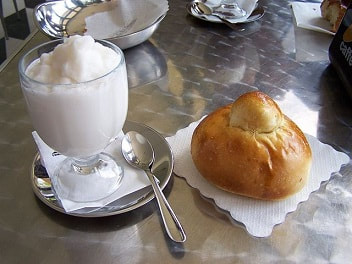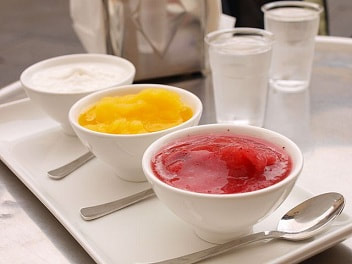|
Nero, master of excess in his time, is reputed to have positioned runners along the Appian Way to relay buckets of fresh mountain snow to his kitchens. When his chefs had completed reattaching the feathers to a now roasted peacock, they mixed the snow with honey and wine for a palate cleanser between courses. We have our own excess masters today, who vie for the most excessive birthday celebrations and the most unique, and nearest extinction, delicacies for their tables. Fortunately, most of us don’t have to go that far. The advent of artificial freezing has given us refreshing, frozen desserts without excess of any sort. There are many such chilly treats, some for children and others for adults, some elegant, others commonplace. World renown among them are the sophisticated Italian granitas. Comparing granitas to snow cones is the equivalent of comparing truffles to garlic or ramps to scallions. Whatever your favored form of Democracy, granitas occupy an elite class. Happily, they are not difficult to produce. Like much else in the world, once you know the tricks and the particularities, it’s a snap. Granita, basically a flavored ice, differs from sorbet in few distinct ways: sorbets may contain dairy products; they are smooth, almost creamy whether they contain dairy products or not; and sorbets are made in a freezing machine, while granitas are made by hand stirring or scratching. Granitas are made up of distinct crystals of flavored ice. The goal is to create uniformly small separated crystals, shards if you will. The process is not complex but requires some little attentions. Coffee granita is one of the most elegant and popular ways to complete a meal. Incongruously, coffee granita is one of the most simple to make. Traditionally most granitas are made with the juice of fresh fruit, water and sugar. Modern chefs are creating exciting new granitas with nuts, tomato, corn, herbs, and edible flowers. Unlike sorbets and ice creams, granitias can better achieve those individual crystals when the pulp of the flavor source is removed. Sicily lays undisputed claim to the origin of granita. Each city and village still seems to have its own prized version. The texture varies somewhat as well. On the western coast and in Palermo, folks prefer a chunkier texture, while the inhabitants of the east coast lean toward a smoother mixture. The popularity of the dessert however has spread throughout Italy and is making its way around the globe. Please do your part. Here are a couple of recipes to help you on your way: Fresh Strawberry Granita, and the traditional Coffee Granita. Before I tasted the result of the strawberry granita, I thought it was a shame to use really fine strawberries that way. After tasting it, I made a little container to hoard just for myself.
0 Comments
Leave a Reply. |



